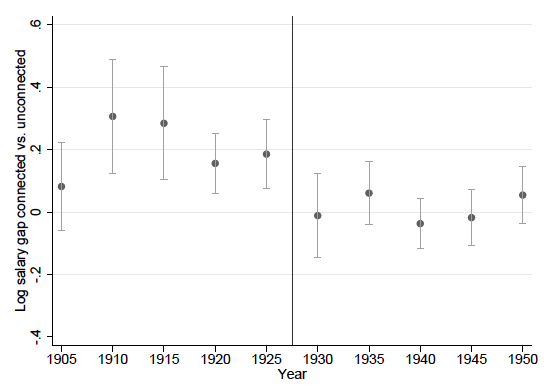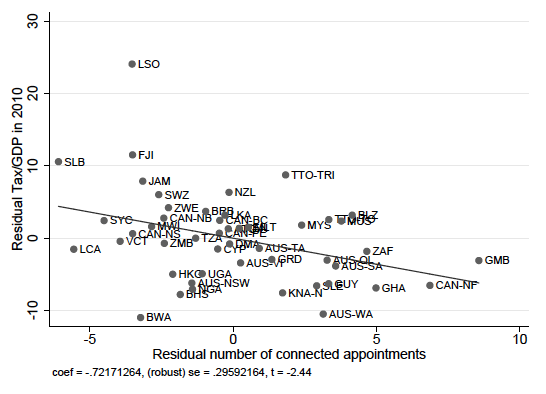
Data on the British Empire show patronage in civil service appointments was a good system for those who got jobs but bad news for almost everyone else
A growing concern among policymakers is that patronage – the discretionary appointment to public office – undermines government effectiveness. Patronage appointments, however, have always been ubiquitous (Grindle 2012) – from chiefdoms and royal courts to modern-day presidents, in developing and developed countries alike.
Despite the ubiquity of patronage as an allocation mechanism, there is little empirical evidence on how this practice affects public sector performance. In theory, the impact of patronage would be ambiguous (Aghion and Tirole 1997, Prendergast and Topel 1996). On one hand, patronage may mitigate moral hazard through better information and the appointment of loyal subordinates. On the other hand, discretionary power can also be abused by biasing the allocation of positions in favour of socially connected subordinates. As these bureaucrats are responsible for raising revenue, providing public services and implementing reforms, and so make up a key element of state capacity, it is important to understand how patronage affects performance.
I have been studying patronage through the lens of a historical bureaucracy that spanned the globe, namely, the Colonial Office (Xu 2017). The Colonial Office was a ministry in charge of administering the British Empire through its colonial governors. Governors were senior bureaucrats that headed up colonies. At its peak, governors were responsible for administering a territory that covered one-fifth of the earth’s land mass.
My study exploits a change in the allocation regime within the ministry. In the early period of the Colonial Office (1854-1930), the Secretary of State had full discretion over the appointment of governors – in the words of the colonial regulations, the Secretary of State “enjoyed the privilege of patronage”. After 1930, a civil service reform called the Warren Fisher Reform removed the Secretary of State’s right of patronage by limiting the Secretary of State’s discretion in appointments through an independent civil service board. I combine this natural experiment – the abolition of patronage – with changes in social connections induced by the ministerial turnover in London. This allows me to study whether differences in the promotion and performance of socially connected bureaucrats varied with the extent of discretionary appointments.
Studying bureaucracies is not easy, because of the lack of data available to researchers. To overcome this, I undertook a large-scale digitisation of historical administrative reports to combine colonial and public finance data. Over three years I digitized more than 3,000 administrative reports from the National Archives, which involved photographing more than 135,000 pages of historical documents. This is the first time that colonial personnel and public finance data have been combined into a single dataset covering the entire period of the British Colonial Office (1854-1966), all colonial governors, and the 70 colonial territories under the control of the ministry.
To measure social connections, I collected data on family trees and biographies. This allows me to measure connections by shared ancestry and membership of the British aristocracy, attendance of same elite school or university. To measure performance, I exploit the fact that revenue generation was a key performance dimension of the Colonial Office. Just as in the study of CEOs and leaders (Bertrand and Schoar 2003, Jones and Olken 2005), the seniority of governors allowed me to map colony-level performance to individual governors. This allows me to relate aggregate fiscal performance to individual connectedness, again before and after the removal of patronage.
Pay, performance, misallocation, and persistence
There are four major findings from my research:
- Connected governors earned more. They received higher salaries during the period of patronage. Wages are fixed across positions, but this increase was driven by allocation to higher-salaried colonies. These colonies were more desirable positions that were larger, closer to London, and with lower settler mortality rates. This salary gap vanished after the removal of patronage.
Figure 1 Salary gap and the removal of patronage (Warren Fisher Reform, 1930)

Notes: Difference in (log) salaries for connected and unconnected governors around the Warren Fisher Reform 1930 (solid vertical line). The salary gaps are estimated with an extension of specification (10), where connectedness is allowed to vary by five year bins.
- Connected governors were poor performers. Once allocated to serve their six-year terms, governors generated less revenue during years connected to their superior, invested less in public goods, provided more tax exemptions (which primarily benefited the settler elite) and experienced more social unrest in their colonies. Again, these negative performance differences disappeared after the removal of patronage.
- Patronage induced misallocation. Using a bureaucratic rule to predict the appointment of governors unrelated to fixed colony-level characteristics, I found that revenue and investments grew less under governors that were connected when appointed. The removal of patronage mitigated this negative gap and the allocation of governors to colonies became assortative, indicating an improved match quality.
- Patronage has had persistent effects. I found that modern countries exposed longer to connected governors during the period of patronage exhibit lower fiscal capacity today. Consistent with policy persistence and the tax exemptions granted in the colonial period, these countries still have lower-quality tax systems. As before, the exposure to connected governors after the removal of patronage has had no long-run impact.
Figure 2 Current tax/GDP and connected appointments under patronage

Notes: Second stage (IV) partial correlation between the regional tax/GDP ratio in 2010 and the number of connected appointments 1854-1930. Controlling for the years under British rule, (log) initial governership salary, the share of land area within tropics and absorbing continent fixed effects. Robust standard errors.
These results provide evidence that patronage had high costs for the British Empire and the independent countries that emerged from it following decolonisation. The key lesson from history for modern bureaucracies is that reforms aimed at curtailing discretion in the appointment of bureaucrats may improve the effectiveness and economic performance of the entire government. This is particularly so in the case of senior, more consequential bureaucrats, although it is precisely these senior positions that still remain under patronage today.
Editor’s Note: This article is based on an IGC project.
Photo credit: Royal Commission on the Ancient and Historical Monuments of Scotland.
References
Aghion, P and J Tirole (1997), “Formal and Real Authority in Organizations”, Journal of Political Economy 105: 1-29.
Bertrand, M and A Schoar (2003), “Managing with Style: The Effect of Managers on Firm Policies”, The Quarterly Journal of Economics 118: 1169-1208.
Grindle, M (2012), Jobs for the Boys: Patronage and the State in Comparative Perspective, Cambridge, MA: Harvard University Press.
Jones, B F and B A Olken (2005), “Do Leaders Matter? National Leadership and Growth since World War II”, The Quarterly Journal of Economics 120: 835-864.
Prendergast, C and R H Topel (1996), “Favoritism in Organizations”, Journal of Political Economy, 104: 958-978.
Xu, G (2017), "The Costs of Patronage: Evidence from the British Empire", working paper.

